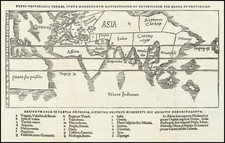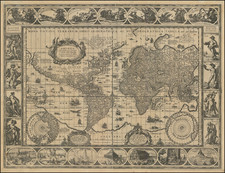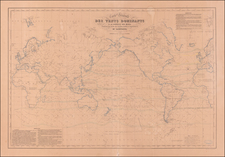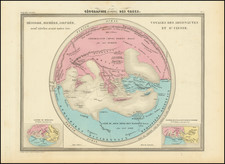One of the Earliest Obtainable World Maps To Show America
Rare early world map, published by Gregor Reisch in his Margarita Philosophica.
In 1513, for the first time, Reisch included this modern world map idrawn up from that of Martin Waldseemüller, which followed the Ptolemaic pattern and regional layout, while modernizing the names of the regions, which he updated in 1515. The versions published in Strasbourg in 1513 and 1515 thus moved away from the Ptolemaic cartographic model to present a modern image of the world. Nevertheless, the map retained the Ptolemaic regional layout which was its central theme: Typus universalis terrae, iuxta modernorum distinctionem and extensionem per regna et provincias. The regions (regna and provinciae) were roughly delimited by straight lines and their names appeared either on the map itself (edition of 1515) or in the form of alphabetical references to a list of names of the 26 regions published just below: Regionum loca in tabula expressa, literulis propriis nominibus hic adjectis demonstrantur.
Published the same year as the Waldseemuller Ptolemy with its world map, the map actually relates to the large Waldseemuller map of three year later, the Carta Marina of 1516. Either the Reisch is based on a prototype of the 1516 work no longer extant, or (more probably) Reisch combined Waldseemuller's 1513 world and America maps into an interesting and precient world map, pre-dating the Carta Marina.
The map is the one of the earliest obtainable maps of the World to show any part of America, preceded only by the following maps:
- 1506 Contarini-Roselli: (1 known example)
- 1507 Ruysch
- 1507 Waldseemuller (1 known example)
- 1507 Waldseemuller globe gores (2 known examples)
- 1508 Roselli (3 known examples)
- 1508 Rosellli (2 known examples)
- 1511 Sylvanus
- 1512 Stobnicza (2-3 known examples, plus several of questionable authenticity)
Reisch was one of a group of southern German humanists, along with Martin Waldseemüller or Matthias Ringmann, who sought to move past Ptolemy and other ancient sources, in order to create a more modern structure of the world. The leader and provacateur of this circle was Gregor Reisch, confessor of Maximilian I, and author of the Margarita philosophica, an encyclopedic textbook for teaching. The book was a great editorial success and went through several editions.
Rarity
The map is rare on the market.
Gregor Reisch (1467-1525) was born in Balingen, Württemberg. He entered the University of Freiburg in 1487, graduating with the degree of magister in 1489. After his studies, he entered the Carthusian Order. From 1500 to 1502 he was prior at Klein-Basel. He then returned to Freiburg as prior, serving from 1503 to shortly before his death.
Reisch was well respected and served as confessor to Maximilian I. He was also acquainted with a broad network of Humanists, including Erasmus, Wimpfeling, Beatus, Rheananus, Udalricus Zasius, and the celebrated preacher, Geiler of Kaisersberg. These contacts admired Reisch’s wide-randing knowledge and insight.
Reisch is best known today for his Margarita Philosophica, the first modern encyclopedia to appear in print and a landmark in the history of modern science. Constructed as a dialog between teacher and student, the textbook served as a primer for the university curriculum. Reisch divided the text into twelve books: (1) Grammar, (2) Dialectic, (3) Rhetoric, (4) Arithmetic, (5) Music, (6) Geometry, (7) Astronomy, (8) Principles of Natural Philosophy, (9) Origin of Natural Objects (containing references to minerals, metals and mining), (9) Psychology, (10) Logic, and (12) Ethics. Alexander von Humboldt said of that Reisch's book "for a half-century, aided in a remarkable manner the spread of knowledge."
The Margarita Philosophica was also known for its full index and fine woodcuts. These included a world map, which is important to the history of cartography.











![[Pacific Ocean Centric World Map] Mappe-Monde Sur la Projection de Mercator Carte Encyprotype Dediée et Présentée à Monsieur](https://storage.googleapis.com/raremaps/img/small/69294.jpg)



![[WWI British Propaganda Map in Italian] L’impero Britannico in Guerra](https://storage.googleapis.com/raremaps/img/small/86441.jpg)